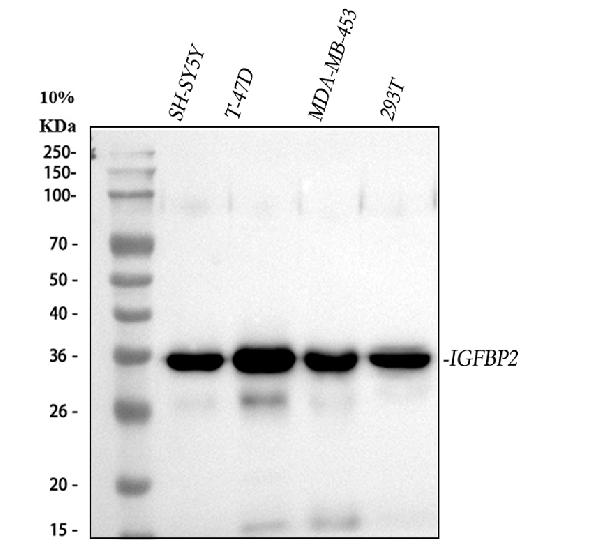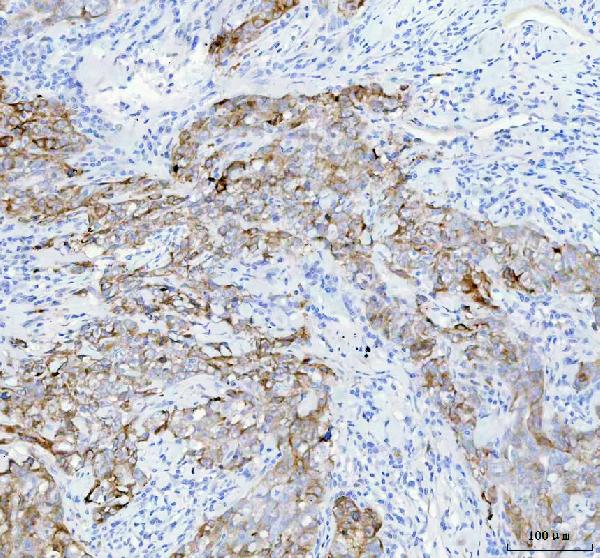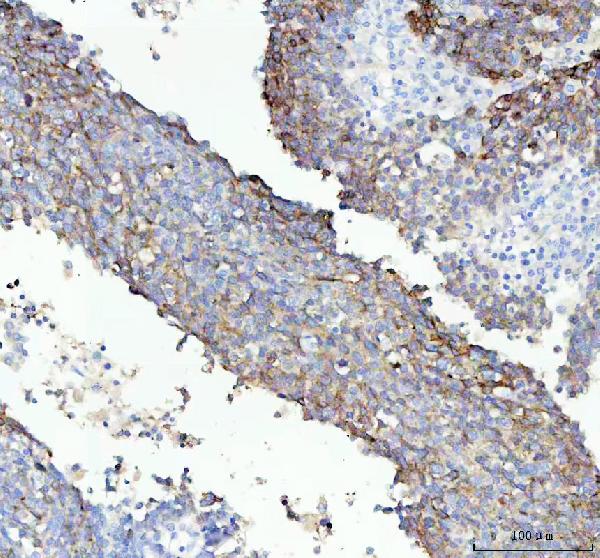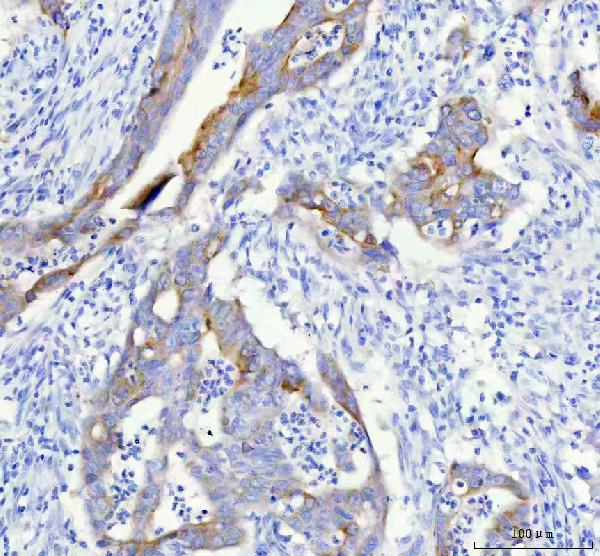Anti-IGFBP2 Rabbit Monoclonal Antibody
- SPECIFICATION
- CITATIONS
- PROTOCOLS
- BACKGROUND

Application
| WB, IHC |
|---|---|
| Primary Accession | P18065 |
| Host | Rabbit |
| Isotype | IgG |
| Reactivity | Human |
| Clonality | Monoclonal |
| Format | Liquid |
| Description | Anti-IGFBP2 Rabbit Monoclonal Antibody . Tested in WB, IHC applications. This antibody reacts with Human. |
| Gene ID | 3485 |
|---|---|
| Other Names | Insulin-like growth factor-binding protein 2, IBP-2, IGF-binding protein 2, IGFBP-2, IGFBP2, BP2, IBP2 |
| Calculated MW | 35 kDa |
| Application Details | WB 1:1000-1:5000 IHC 1:50-1:200 |
| Contents | Rabbit IgG in phosphate buffered saline, pH 7.4, 150mM NaCl, 0.02% sodium azide and 50% glycerol, 0.4-0.5mg/ml BSA. |
| Clone Names | Clone: 19I49 |
| Immunogen | A synthesized peptide derived from human IGFBP2 |
| Purification | Affinity-chromatography |
| Storage | Store at -20°C for one year. For short term storage and frequent use, store at 4°C for up to one month. Avoid repeated freeze-thaw cycles. |
| Name | IGFBP2 |
|---|---|
| Synonyms | BP2, IBP2 |
| Function | Multifunctional protein that plays a critical role in regulating the availability of IGFs such as IGF1 and IGF2 to their receptors and thereby regulates IGF-mediated cellular processes including proliferation, differentiation, and apoptosis in a cell-type specific manner (PubMed:18563800, PubMed:38796567). Functions coordinately with receptor protein tyrosine phosphatase beta/PTPRB and the IGF1 receptor to regulate IGF1-mediated signaling by stimulating the phosphorylation of PTEN leading to its inactivation and AKT1 activation (PubMed:22869525). Plays a positive role in cell migration via interaction with integrin alpha5/ITGA5 through an RGD motif (PubMed:16569642). Additionally, interaction with ITGA5/ITGB1 enhances the adhesion of endothelial progenitor cells to endothelial cells (PubMed:26076738). Upon mitochondrial damage, facilitates apoptosis with ITGA5 of podocytes, and then activates the phosphorylation of focal adhesion kinase (FAK)-mediated mitochondrial injury (PubMed:38796567). |
| Cellular Location | Secreted |

Thousands of laboratories across the world have published research that depended on the performance of antibodies from Abcepta to advance their research. Check out links to articles that cite our products in major peer-reviewed journals, organized by research category.
info@abcepta.com, and receive a free "I Love Antibodies" mug.
Provided below are standard protocols that you may find useful for product applications.
If you have used an Abcepta product and would like to share how it has performed, please click on the "Submit Review" button and provide the requested information. Our staff will examine and post your review and contact you if needed.
If you have any additional inquiries please email technical services at tech@abcepta.com.













 Foundational characteristics of cancer include proliferation, angiogenesis, migration, evasion of apoptosis, and cellular immortality. Find key markers for these cellular processes and antibodies to detect them.
Foundational characteristics of cancer include proliferation, angiogenesis, migration, evasion of apoptosis, and cellular immortality. Find key markers for these cellular processes and antibodies to detect them. The SUMOplot™ Analysis Program predicts and scores sumoylation sites in your protein. SUMOylation is a post-translational modification involved in various cellular processes, such as nuclear-cytosolic transport, transcriptional regulation, apoptosis, protein stability, response to stress, and progression through the cell cycle.
The SUMOplot™ Analysis Program predicts and scores sumoylation sites in your protein. SUMOylation is a post-translational modification involved in various cellular processes, such as nuclear-cytosolic transport, transcriptional regulation, apoptosis, protein stability, response to stress, and progression through the cell cycle. The Autophagy Receptor Motif Plotter predicts and scores autophagy receptor binding sites in your protein. Identifying proteins connected to this pathway is critical to understanding the role of autophagy in physiological as well as pathological processes such as development, differentiation, neurodegenerative diseases, stress, infection, and cancer.
The Autophagy Receptor Motif Plotter predicts and scores autophagy receptor binding sites in your protein. Identifying proteins connected to this pathway is critical to understanding the role of autophagy in physiological as well as pathological processes such as development, differentiation, neurodegenerative diseases, stress, infection, and cancer.





